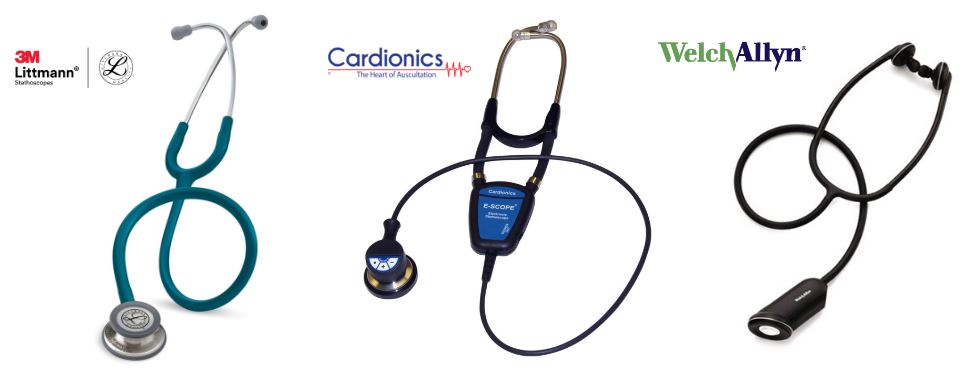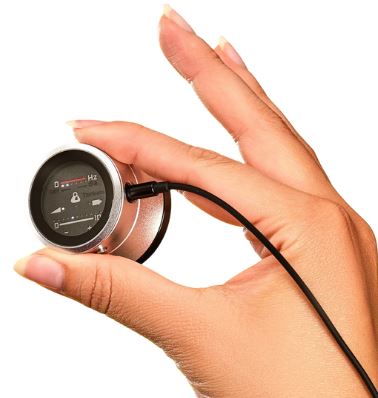Hearing loss forms part of the global burden of disease, where over 430 million people suffer from disabling hearing loss. Hearing loss does not discriminate and is no exception across healthcare workers.
A critical job function for many medical professionals, including doctors, nurses, veterinarians, and others, is the ability to use a stethoscope. They use a stethoscope to listen to internal parts of the body, such as the heart and lungs; this process of using a stethoscope to hear sounds normally unhearable to the naked ear is known as auscultation. Through auscultation, medical professionals can analyze heart and lung sounds for differential diagnosis. Doctors rely on this tool to determine the function of certain circulatory, respiratory, and gastrointestinal systems. Nurses, for example, use stethoscopes to hear a pulse when measuring blood pressure.
Traditionally stethoscopes work by transmitting sound from a diaphragm/bell chest-piece through an air-filled tube to the earpieces. The diaphragm and bell are both designed to pick up the low-frequency sounds generated by our body. The disc-shaped diaphragm picks up the relatively higher frequency sounds of breathing and the lungs, which fall in the 70 to 4,000 Hertz (Hz) range. The bowl-shaped bell on the other side of the chest piece is designed to pick up lower frequency sounds in the 20 to 650 Hz range, such as the heartbeat.
 This can be a challenge for persons with hearing impairment in this region as heart and lung signals are considered very soft, low frequency (LF) sounds.
This can be a challenge for persons with hearing impairment in this region as heart and lung signals are considered very soft, low frequency (LF) sounds.
Persons with hearing impairment face difficulties as the required low-frequency bandwidth for auscultation falls beyond the capability of conventional hearing aids designed for speech understanding. The reluctance to self-identify hearing loss, often exacerbated by fears of job insecurity, compounds the problem. The misconception that individuals with hearing aids cannot effectively use a stethoscope further hinders their participation in healthcare professions.
Despite these challenges, the inability to hear subtle heart sounds should not hinder clinicians from delivering optimal care. There are diverse hearing aids and innovative tools available to address these concerns, empowering clinicians with hearing impairment to confidently provide the best care possible.
Stethoscope Solutions for Medical Professionals with Hearing Loss
Addressing hearing loss among medical professionals during auscultation involves considering various options, with the most suitable choice contingent on factors such as:
- For medical professionals who wear hearing aids, the decision to retain or remove them during auscultation.
- The style of hearing aid they use plays a crucial role in determining available options.
- The features of the hearing aid, such as t-coil compatibility or streaming capabilities, influence the selection of a compatible stethoscope.
The preferences of the medical professional and the specific attributes of their hearing instrument guide the decision-making process. Fortunately, numerous options cater to different needs.
Patience becomes a key virtue in navigating this process, allowing medical professionals to identify the most effective means of enhancing their auditory experience during auscultation.
Stethoscope options for different situations:
Without Hearing Aids
If the professional does not use hearing aids but is aware of a decline in how they hear through their standard stethoscope, an amplified stethoscope is an option.
- Note: Age-related hearing loss typically affects the high-frequency spectrum, and the low frequencies may remain unaffected. In such cases, professionals can continue using their standard stethoscope, provided there is a formal diagnosis supporting this. Additionally, regular monitoring should be implemented to detect any changes in hearing loss, particularly in the low frequencies.

Amplified Stethoscopes
Who they are designed for:
Amplified stethoscopes cater to medical professionals with mild to moderate hearing loss who either do not wear hearing aids or choose to remove them during auscultation. They prove beneficial for those struggling with low-frequency sounds, such as heart and lung signals, and may not necessarily require hearing aids for daily activities.
How They Work:
Amplified stethoscopes for the hearing impaired typically feature two listening modes: a bell mode for low-frequency heartbeats and a diaphragm mode for higher frequency lung sounds. These devices, similar to personal sound amplification products, elevate decibel levels (15 to 50 dB) to make internal body sounds more audible. Some models even allow headphones to be plugged in for added convenience.
Considerations:
While amplified stethoscopes offer enhanced sound, they may not be suitable for individuals with significant hearing loss. The amplification may not be sufficient, and these devices lack the personalized tuning found in hearing aids.
Commercial Options on the Market
Several reputable brands offer amplified stethoscopes with traditional earpieces. Notable options include the Adscope, E-Scope II with standard earpieces, 3M Littmann, and the ThinkLabs Ds328+. Additionally, the Philips Medical Systems Electronic Stethoscope and the Thinklabs One Digital Stethoscope, designed for cardiologists, provide alternatives with unique features.
Amplified Stethoscope Brands to Consider
3M Littmann Classic III Stethoscope:
- Features a tunable diaphragm suitable for pediatric and adult patients.
- Soft-sealing ear tips ensure comfort and optimal audibility.
Welch Allyn Elite Electronic Stethoscope:
- Two-option switch for focusing on low or high-frequency sounds.
- Optional accessories for capturing and recording sounds.
Cardionics E-Scope II:
- Amplifies body sounds while filtering out background noise.

For medical professionals seeking enhanced auditory experiences during auscultation, these amplified stethoscope options offer a bridge between hearing loss and the demands of their crucial roles.
It’s essential to consider personal preferences, the severity of hearing loss, and the specific features required for optimal performance.
Stethoscope Options for Individuals with Hearing Aids
Addressing the auditory needs of medical professionals with hearing aids requires a tailored approach, recognizing the diversity in hearing aid styles and individual preferences. While there is no universal solution, understanding the characteristics of different hearing aids can guide medical professionals toward suitable stethoscope options.
Hearing Aid Styles and Corresponding Solutions:
- Invisible Hearing Aids:
Utilize regular or amplified stethoscopes, ensuring comfort with the earpieces. Alternatively, use a stethoscope connected to a headset for deeper-seated devices.
- Open Fit, Behind the Ear:
Consider amplified stethoscopes with tips fitting into the ear canal alongside the hearing aid dome. Use a headset if more comfort is desired.
- In the Ear and Completely in the Canal:
Explore stethoscopes connected to headsets for optimal compatibility.
- Behind the Ear with Earmolds:
Modify the earmold to include a stethoscope vent, allowing the use of amplified stethoscopes directly targeting hearing loss. A large vent earmold can also accommodate a headset.
Stethoscope Adaptations for Hearing Aids:
- In-Ear or Canal Hearing Aids (CIC or ITC): Utilize stethomates, special adaptors replacing regular earpieces on acoustic and amplified stethoscopes for compatibility.
- Behind-the-Ear (BTE) with Induction Loop (T-Coil): Use an amplified stethoscope with induction loop technology, transmitting sound directly to hearing aids via telecoils.
- BTE with Direct Audio Input (DAI): Directly plug an amplified stethoscope into the hearing aid via a cable, with the possible addition of a DAI boot or shoe.
- General Hearing Aid Use: Explore stethoscopes with headphone jacks, pairing them with over-the-ear or on-ear headphones that can accommodate most hearing aid styles.
Additional Solutions and Considerations:
- Ear Tips and Molds: Replace hard plastic stethoscope earpieces with silicone tips, considering ear size and pressure tolerance.
- Scenario-Based Solutions: Tailor solutions based on specific scenarios, such as medical professionals wanting to keep hearing instruments in the ears.
- Realistic Expectations: Acknowledge potential challenges with Bluetooth-enabled stethoscopes and set realistic expectations for optimal outcomes.
While a universal solution may be elusive, these scenarios offer diverse options for audiologists working with patients. It’s crucial to have various solutions readily available during appointments, recognizing that successful outcomes may vary.
Direct Connections:
Direct connections to the stethoscope typically involve a wired connection, often referred to as a direct audio interface (DAI). This connection directly plugs into the audio input of the hearing aid.
DAI for stethoscopes and hearing aids can be used with various types of hearing aids, not limited to behind-the-ear (BTE) devices. DAI is a feature that allows audio signals from external devices, such as stethoscopes, to be directly input into the hearing aids. This functionality is available in different hearing aid styles, including in-the-ear (ITE), in-the-canal (ITC), completely-in-the-canal (CIC), and BTE.
However, the specific compatibility may vary based on the individual hearing aid model and its features. It is recommended to consult with the hearing aid manufacturer or an audiologist to determine if a particular hearing aid supports DAI and how to properly set it up for stethoscope use.
Connector Adaptations for Behind-the-Ear (BTE) Hearing Aids:
- A connector allows a cord to run directly from the stethoscope to the bottom of the BTE hearing aid.
- Signal travels through the hearing aid’s processor, requiring verification by an audiologist to ensure adequate low-frequency transmission
Choosing Hearing Aids for DAI Interface:
- Prioritize hearing aids with good low-frequency response when planning to interface with stethoscopes via DAI.
- Ensure the hearing aid microphone deactivates during DAI activation to prevent interference from room noise.
Telecoil-Equipped BTE Hearing Aids:
- If your BTE hearing aid features a telecoil, a silhouette connection to the stethoscope can be employed.
- Silhouettes, positioned behind the hearing aids, transmit signals wirelessly. Ensure telecoil program setting activation and audiologist confirmation for low-frequency suitability.
Wireless Connections:
- Many modern stethoscopes are equipped with Bluetooth technology, allowing them to wirelessly connect to Bluetooth-enabled hearing aids.
- Bluetooth connectivity enables seamless audio transmission, providing a direct and clear signal to the hearing aids
- In addition to connecting to the hearing aids, some of these wireless technologies including connection to a user-friendly app that can be used on a smartphone to assist with the auscultation process.
- Gateway devices for wireless connections:
- A gateway device refers to an intermediary device that facilitates wireless connectivity between the stethoscope and the hearing aids. The gateway device typically transmits the audio signals from the stethoscope to the hearing aids, allowing the user to hear amplified sounds directly through their hearing aids. This can be particularly useful for individuals with hearing loss who rely on hearing aids for improved auditory perception.
- The gateway device uses wireless technology to transmit audio signals from the stethoscope to the hearing aids.
- Gateway devices are designed to work with specific stethoscopes and hearing aids, and their compatibility may vary. It’s essential to ensure that the stethoscope, gateway device, and hearing aids are all compatible with each other.
- Some gateway devices may allow users to control the level of amplification, providing a customizable listening experience.
- It’s advisable to consult with an audiologist or hearing healthcare professional when choosing and configuring a gateway device to ensure optimal compatibility and performance.
Brands to consider:
E-Scope Electronic Stethoscope:
- Wide frequency range and high amplification.
- Belt-clip model with audio output jack for headphones, DAI cable, or CI cable.
- Successful for CIC and ITE users; headphones connect to the stethoscope’s output jack.
 Thinklabs One and Hearing Aids:
Thinklabs One and Hearing Aids:
- Integration: Connect over-ear or on-ear headphones to the Thinklabs One digital stethoscope.
- Smallest and most powerful stethoscope, amplifying up to 100 times.
- Comes with insert earphones for use with hearing aids, or pairs with high-quality headphones like Beats Executive, SoundTru, or Monster DNA.
- Advantage: Large headphone design accommodates hearing aids effectively.
- Transmitter Option: Consider a transmitter like the Cochlear Mini-Microphone, transmitting Thinklabs One sounds directly to hearing aids with guidance from your audiologist and hearing aid company.
 Eko App Visualization:
Eko App Visualization:
- Enhancement: Pair a stethoscope with the Eko App for real-time visualization of heart sounds waveforms (PCG).
- Eko Duo ECG + Digital Stethoscope:
- Features an app for recording heart and body sounds.
- Provides detailed visualization of waveforms for additional diagnostic support.
- Benefits: Visual cues enable simultaneous viewing of heart abnormalities during auscultation.
- Detail:* Detailed visual waveform aids clinicians who prefer assessing patients using visual cues.
Stemoscope PRO and Bluetooth:
-

Streaming Capability: Stemoscope PRO, an amplified stethoscope, streams sound directly to Bluetooth earphones.
- Tip: Choose earphones with high output power for optimal amplification. Bluetooth headphones are recommended for better low-frequency sound transmission.
- Caution: Avoid earbuds without silicone tips, as they may not provide sufficient low-frequency amplification crucial for auscultation sounds.
Cardionics E-Scope II:
- Offers a maximum volume of 120 dBA, paired with headphones worn over hearing aids.
Phonak Stethoscope Options:
- Configurations for stethoscopes with headphones based on hearing aid style (ActiveVent™, BTEs, RICs, ITEs).
- Streaming options include RogerDirect™, Bluetooth connectivity, and Bluetooth streaming with considerations for hearing aid factors.
Interface considerations:
Eartips/Earmolds:
- Specialty earmolds tailored for ITC, CIC, and BTE hearing aid users are available.
- Some BTE users experiment with inserting the stethoscope earpiece into earmold vents.
- Specialty ear tips replacing standard stethoscope tips are available but have a historical low success rate.
- Alignment challenges with the hearing aid microphone may cause discomfort.
Headphones:
- Suitable for ITE, CIC hearing aids, and potentially ear-level processor cochlear implants.
- Choose headphones with excellent low-frequency response.
- Cardionics provides a stethoscope with headphones.
- Adjustments can be made if feedback occurs by modifying volume settings.
Direct Audio Input (DAI):
- Connects stethoscope output to BTE hearing aid through audio input shoes and a DAI cable.
- BTE aids with good low-frequency response are ideal.
- Programmable hearing aids may enhance low-frequency performance.
- Consult the manufacturer’s engineer for compatibility and potential DAI cord attenuation.
Telecoil:
- Silhouette designed for hearing aids with telecoils available for BTE and some ITE users.
- Programming adjustments may be necessary for optimal telecoil low-frequency response.
- Test telecoil option in usual work environments for potential interference.
- Assess interference by turning hearing aid to telecoil mode.
Other Interfaces:
- Use of an FM system with a stethoscope in specific instances.
- Auxiliary cable connects stethoscope to FM transmitter, transmitting signal to FM receiver.
- Cochlear implant users can use a patch cord from stethoscope to speech processor.
- Attenuation may be required to prevent overload.
- Output characteristics of the patch cord must match the input jack of the speech processor; adapters can be added if necessary.
Special Considerations:
When individuals with hearing aids use a stethoscope, the hearing aid microphones often remain active, amplifying ambient sounds. This can be distracting, but audiologists can create custom hearing aid programs to deactivate the microphones during stethoscope use, either manually or remotely.
The goal is to avoid the impracticality of frequently removing and replacing hearing aids.
Stethoscopes and Hearing Loss Issues:
Medical professionals, like anyone else, may experience various degrees of hearing loss. Digital hearing aids, designed to address specific frequency losses, can sometimes pose challenges when used in conjunction with stethoscopes. Issues may arise, such as traditional stethoscope ear tips not aligning well with in-the-canal (ITC) hearing aids or difficulties amplifying low-frequency sounds crucial for heart and breath sounds.
Modifications and Emerging Technologies:
Ongoing projects and visual technologies are exploring solutions for medical professionals with hearing loss. FDA-approved stethoscopes mentioned in this article have been adapted or modified by engineers to meet specific gain requirements. Some experiments involve building transmitters into stethoscopes to transmit via FM to hearing aids.
Appropriate ”stethoscope programming” for this specific purpose is encouraged and can easily be accomplished in many hearing aids with multiple memory functions.
Latest developments reveal that there are stethoscopes that have been developed that digitally transposes heart sounds to higher frequencies, where they may be more audible to certain people with certain hearing aids.
Networking and Support:
There are associations like ”Association of Medical Professionals with Hearing Losses” (AMPHL) and other organizations that provide a valuable network for medical professionals and students, offering support, advocacy, and updates on the latest developments in the field.
Other Factors to Consider:
For those keeping hearing aids in during auscultation, audiologists can program settings to capture very low frequencies associated with heartbeats and breathing. Cochlear implant users can connect several amplified stethoscopes directly to their processor via a patch cord or opt for devices providing visual readouts of picked-up sounds.
In the dynamic landscape of stethoscope technology, ongoing advancements and adaptive solutions aim to enhance the experience for medical professionals with hearing aids, ensuring seamless integration into their daily practice.
Aural Rehabilitation Applications:
Learning to Identify Body Sounds with Stethoscopes for Hearing Loss
- Optimal operation: Acquiring proficiency in using stethoscopes with hearing aids involves a learning process. Resources like online platforms offering body sounds can aid in distinguishing heart murmurs and lung sounds using hearing instruments and computer speakers.
- Enhance learning: Visual display stethoscopes, compatible with computer programs, enhance learning. Progress to hands-on practice with teaching mannequins for adjusting sound speed and volume. Regular practice builds confidence. Once proficient, hearing instruments can be reprogrammed optimally.
- Combined learning approach: Complementary clinical information, mentor guidance, and modified exam skills contribute to a comprehensive approach.
Consider All Options for Optimal Stethoscope Use:
When assessing a hearing-impaired medical professional’s stethoscope needs, prioritize factors like the type and degree of hearing loss. The choice of hearing instrument significantly impacts interface and stethoscope options, necessitating careful consideration of professional requirements and personal preferences.
Experimenting with various stethoscopes during trial periods, available from multiple manufacturers, proves beneficial. Regularly contacting manufacturers about product availability and servicing is crucial due to changing market demands.
With persistence and creativity, most hearing-impaired medical professionals can achieve competence in stethoscope use.
Consult with Your Audiologist:
Given that sound amplification and noise reduction are vital for effective stethoscope use, collaborate with your audiologist to identify the best stethoscope option tailored to your hearing devices and degree of hearing loss. Request a customized low-frequency setting from your hearing provider and explore premium hearing aid models with specialized apps for stethoscope compatibility. Stay informed about organizations like AMPHL offering assistive tools and resources.

Keep updated through blogs and websites, which focuses on amplified stethoscopes and related topics for audiologists working with hearing-impaired medical professionals.
Finding Custom Solutions:
Explore the range of solutions connecting stethoscopes to hearing devices, leveraging advancements in hearing aids, cochlear implants, and stethoscope technology. In case of even minor hearing loss, seek consultation with a hearing professional as a medical professional or as a patient seeking quality service.
If opting to use a stethoscope with hearing aids, consider programming a specialized setting emphasizing low-frequency sounds and muting aids to minimize background noise. Collaborate with audiologists, hearing aid providers, and stethoscope companies to fine-tune setups that suit your specific hearing loss.
Remember, with the right support, you can maintain your professional standards while adapting to your unique hearing needs.
Conclusion:
Choosing an effective interface between a hearing aid and a stethoscope poses a significant challenge, but the potential benefits are substantial. Successful solutions enable experienced medical professionals to maintain their positions, and students with hearing loss can pursue careers in nursing and medical programs. Factors such as the type and degree of hearing loss, hearing aid style, and circuitry must be considered when selecting the most suitable approach.
In navigating these considerations, healthcare professionals can ensure that hearing impairment does not impede their ability to use a stethoscope effectively, ultimately promoting inclusivity and equal opportunities in the medical field.
Whether opting for a traditional or tech-savvy solution, products should be thoroughly researched to find the best fit. Working closely with hearing care professionals and leveraging available resources will ensure a seamless integration of stethoscope technology into your practice.
About the Author
 Nausheen Dawood is an experienced Audiologist and Project Manager with a professional background including primary health care, corporate social investment, and business development. Proficient in the development of academic courses, training, and lecturing, with a focus on clinical student training and supervision. Adept in freelance copywriting, particularly in audiology and health-related topics. Holds a Masters degree in Audiology (Cum Laude), with a strong foundation in clinical research, project development, and strategic planning, complemented by technical training. Specializes in content development and training tailored to diverse audiences. Demonstrates a long-term commitment to research and development, including the implementation of randomized controlled trials, projects, and clinical examinations. Known for establishing robust networks and cultivating valuable stakeholder relationships.
Nausheen Dawood is an experienced Audiologist and Project Manager with a professional background including primary health care, corporate social investment, and business development. Proficient in the development of academic courses, training, and lecturing, with a focus on clinical student training and supervision. Adept in freelance copywriting, particularly in audiology and health-related topics. Holds a Masters degree in Audiology (Cum Laude), with a strong foundation in clinical research, project development, and strategic planning, complemented by technical training. Specializes in content development and training tailored to diverse audiences. Demonstrates a long-term commitment to research and development, including the implementation of randomized controlled trials, projects, and clinical examinations. Known for establishing robust networks and cultivating valuable stakeholder relationships.







